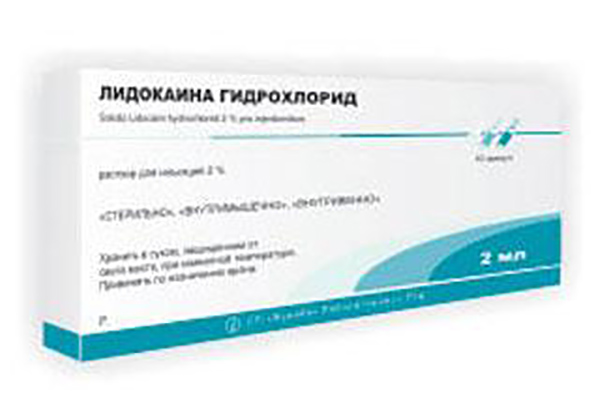Lidocaine hydrochloride

Lidocaine hydrochloride
- Active ingredient (INN):
- Lidocaine (as hydrochloride).
- ATX code: С01ВВ01
- Pharmacotherapeutic group:
- Local anesthetics.
Pharmacological properties
Local anesthetic. Causes all types of local anesthesia: terminal, infiltration, conduction. The local anesthetic effect is due to the inhibition of nerve conduction due to the blockade of sodium channels and nerve endings in nerve fibers. When applied topically, it dilates blood vessels, does not have a local irritating effect. It also has a pronounced antiarrhythmic activity. In the mechanism of this action, an important role is played by the slowing down of the rate of spontaneous diastolic depolarization due to a decrease in the main flow of sodium and an increase in the flow of potassium. The drug reduces the effective refractory period and the duration of the action potential in the Purkinje fibers and the muscles of the ventricles of the heart (IB class of antiarrhythmic drugs). The drug also increases the threshold for ventricular fibrillation. The ECG shows shortening of the QT distance. Myocardial contractility does not decrease or decreases slightly. Does not affect the autonomic nervous system.
Pharmacokinetics
During the first passage through the liver, 70% of the drug is inactivated. The body is distributed in a large volume of fluid. Therapeutic plasma concentrations are 1.5-6 µg/ml, above which the concentration is considered toxic. The degree of binding to plasma proteins is 60-80%. Easily penetrates the placenta and cerebrospinal fluid. Works for a short time. After prolonged infusion, the half-life is 90 minutes. In hepatic diseases, the half-life can increase by 2-3 times. Decomposed in the liver by hydrolysis. It is excreted in the urine as metabolites, with bile, breast milk (up to 40% of the concentration in the mother's plasma).
Indications for use
As a local anesthetic, lidocaine is used for the following purposes: for infiltration anesthesia during appendectomy, hernia repair and other surgical interventions; for conduction anesthesia in dentistry, limb surgery, etc.; for blockade of nerve plexuses; for epidural and spinal anesthesia during operations on the pelvic organs, lower extremities, etc.; for terminal anesthesia of mucous membranes in urology, ophthalmology, dentistry, as well as for various surgical operations and procedures, for bronchoscopy, etc. in the acute stage of myocardial infarction,